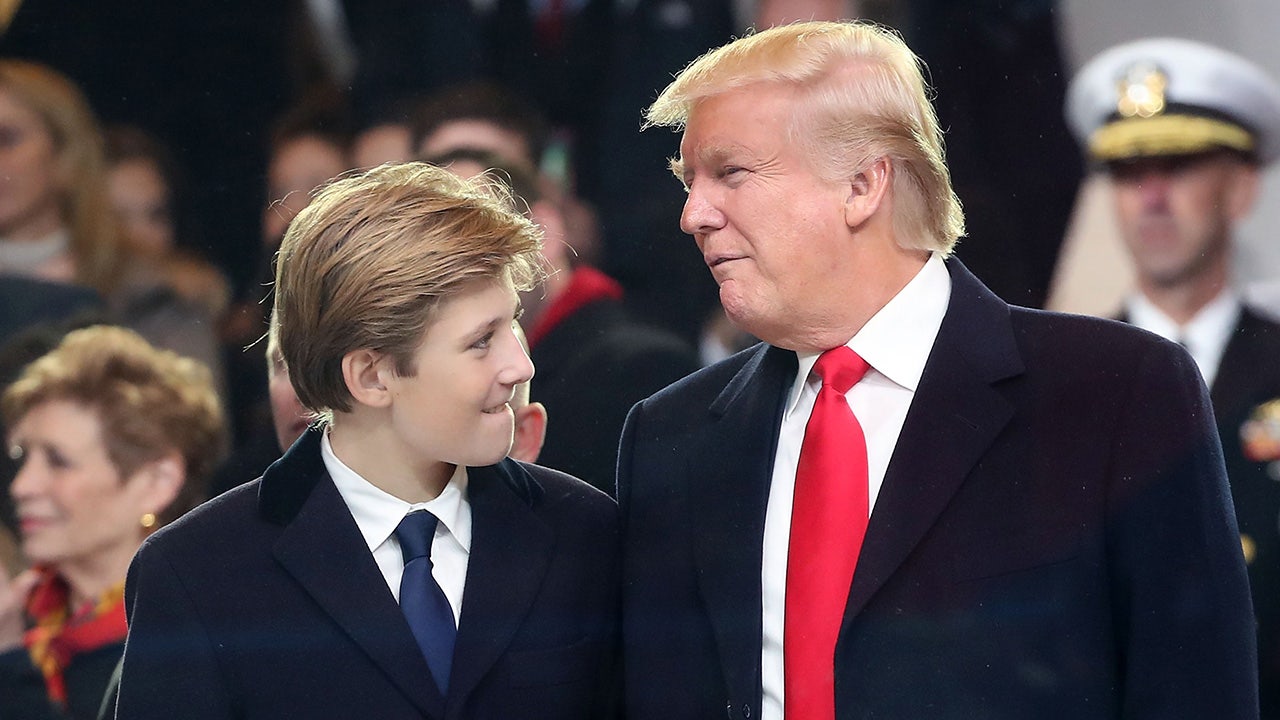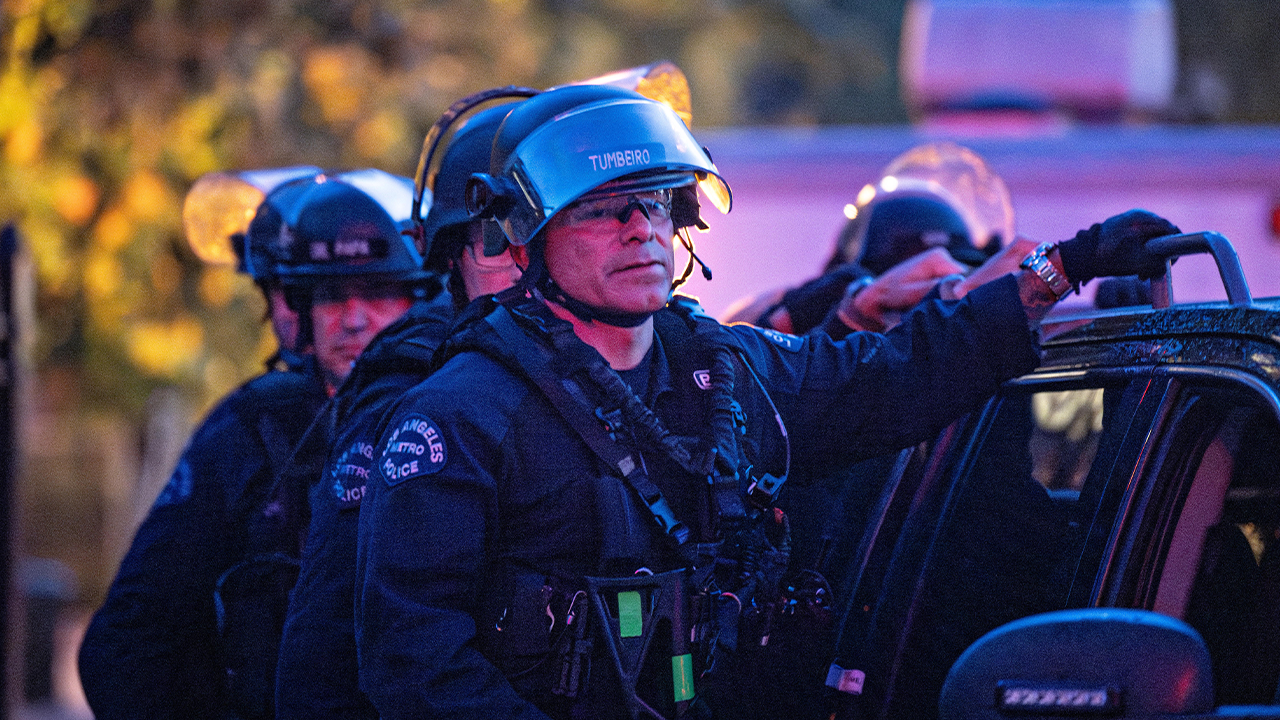Movie Reviews
ALEXXANDAR MOVIE REVIEWS: ‘Past Lives’ worth the time

We recognize you are attempting to access this website from a country belonging to the European Economic Area (EEA) including the EU which
enforces the General Data Protection Regulation (GDPR) and therefore access cannot be granted at this time.
For any issues, call 229-244-1880.

Movie Reviews
“Kingdom of the Planet of the Apes”: Disney's New Kingdom is Far From Magical (Movie Review)

Nearly sixty years removed, it is perhaps all too easy to forget just how radical of a work Franklin J. Schaffner’s original “Planet of the Apes” truly was. In adapting Pierre Boulle’s “La Planète des singes” novel into a feature film, Schaffner and co. maintained the book’s hard science-fiction intellectualism while also infusing it with a radical counterculturalism that resonated so deeply with younger audiences of the time. The resulting film often plays like a feature-length “Twilight Zone” episode in the best of ways, balancing more traditionally thrilling action sequences out with headier diatribes on the human condition, and fittingly so, seeing as it was co-written by Rod Serling himself.
After decades of sequels and one sensationally ill-advised attempt at a Tim Burton-helmed remake in 2001, the “Planet of the Apes” franchise half-stumbled into something remarkable in the 2010s. While “Rise of the Planet of the Apes” was a critical and commercial success, it wasn’t until that film’s sequel, “Dawn of the Planet of the Apes,” that a new legacy was truly cemented, with the addition of writer-director Matt Reeves. Reeves’ films, “Dawn” and “War for the Planet of the Apes,” brought a raw and immediate emotionality to the work that, when paired with similarly excellent elements such as Andy Serkis’ phenomenal lead performance and Michael Giacchino’s decadent musical score, truly brought “Planet of the Apes” to a new generation. In many ways, just as Schaffner’s 1968 film reflected the fears and anxieties of its era and spoke directly to audiences of the day in primal form, so too did Reeves’ films for modern audiences of the 2010s.
It is into this legacy that Wes Ball’s quasi-sequel/quasi-reboot/quasi-legacy-sequel, “Kingdom of the Planet of the Apes,” enters. And while Ball’s film is perfectly functional, competent, and resplendent in its technical achievements, “Kingdom” spends its entire runtime shouldering the burden of the franchise’s history, to its own detriment.
5. WEAK SPOT: THE OPENING
It truly cannot be overstated what a colossal misstep “Kingdom of the Planet of the Apes” takes in its literal opening frames. Opening on the deathbed and funeral pyre of Andy Serkis’ Caesar from the previous trilogy, surrounded by characters from those films, “Kingdom” delivers a fond farewell to these characters and drops its title card, right before hard cutting to a full 300 years later. This is so bizarre for so many reasons (the in-film ‘many generations later’ text is laugh-inducing) but chief among them is that it actively works to put distance between the audience and Noa, the primary character of this film.
Noa doesn’t know who Caesar was and is going to spend the next two-and-a-half hours of runtime finding that out as well as hearing apes debate over Caesar’s teachings and legacy. So opening with Caesar on his deathbed, surrounded by characters who mean nothing to this film, is indulgent at best and detrimental at worst. It prioritizes a quick dopamine hit of nostalgia that serves no purpose over the audience’s actual connection to the present-tense characters and story.
4. THOSE MONKEYS THOUGH
The visual effects, spearheaded by the fantastic team at Wētā FX, continue to be absolutely incredible here. With each successive film in the previous trilogy, the bar was raised for exactly how authentically a human actor’s performance could be translated to the face of a digital ape. “Kingdom of the Planet of the Apes” proudly continues this tradition, allowing its actors’ performances to truly shine through the digital augmentation.
In addition to this, the ape-on-ape action sequences are well-staged here, especially an early one that kicks off Noa’s Campbellian hero’s journey. There’s a visceral quality to the speed and momentum with which the Apes move, which is a fantastic blend of human movement and digital enhancement from Wētā FX. Furthermore, there’s a ton of little details throughout “Kingdom of the Planet of the Apes” that Wētā FX gets precisely right in fascinating ways, specifically in regards to artifacts and artifice of the camera and how the apes look within the frame. The delicate way in which focus shifts occur, the way lens flares react through this digital interface—it’s all exquisitely well-constructed.
3. WEAK SPOT: REHASHING
Director Wes Ball has spoken a lot about how “Kingdom of the Planet of the Apes” takes place 300 years after “War” to introduce audiences to an “Apes” world with exciting new story possibilities. In theory, that sounds perfect for a franchise running for nearly sixty years. However, in execution, that’s not at all what “Kingdom of the Planet of the Apes” delivers.
For many Fox-owned properties, the Disney acquisition has led to surprisingly passionate and off-the-wall new films: Dan Trachtenberg’s “Prey,” Arkasha Stevenson’s “The First Omen,” etc. But “Kingdom” doesn’t feel like a passion project brought to fruition; it feels more like Disney looked at a spreadsheet and realized “Planet of the Apes” was among the most consistently profitable franchises in their new stable and commissioned a new one regardless. Instead of new ideas or stories, “Kingdom” mostly rehashes things audiences have seen before in this franchise.
The sheer number of beats and story ideas that feel recycled, in whole or in part, from either “Dawn of the Planet of the Apes” or Schaffner’s original “Planet of the Apes” is staggering. Even the film’s attempt at an emotional, stakes-heightening climax sets up more conflicts we’ve already seen. Despite the lip-service to paving the way for new stories, “Kingdom” feels like someone shuffled their “Planet of the Apes” greatest hits playlist, and this is what we got.
2. THE HOOK OF RELIGIOUS THEMING
The film’s most intriguing concept is treating Caesar like ape Jesus, despite the absurdity of the notion.
By exploring the idea that Caesar’s ancient teachings have been distorted over centuries to serve the agendas of those with darker motives, “Kingdom” stumbles upon fertile creative territory. Like previous entries in the “Planet of the Apes” franchise, the film has the potential to offer a unique commentary on its contemporary era.
In today’s polarized American society, we witness manipulative figures weaponizing religious texts for personal gain. The antagonist, Proximus Caesar, and his cohorts seem poised to symbolize this phenomenon, offering the beginnings of a pointed allegorical critique.
1. WEAK SPOT: A FAILURE TO ENGAGE WITH SAID THEMING
“Kingdom” initiates an intriguing premise but fails to delve deeper into its potential. While it deserves recognition for introducing this captivating concept, the film disappointingly fails to explore it meaningfully, merely skimming the surface.
As the narrative unfolds, this deficiency becomes more apparent, culminating in a final conflict that feels rushed and disconnected from the central themes. Despite feeble attempts to link the religious motif with human involvement, it devolves into mundane ape versus human conflict, devoid of substance or relevance to the overarching theme.
(C)
“Kingdom” misses a golden opportunity to parallel Caesar’s legacy with that of the “Planet of the Apes” franchise itself. The potential for a poignant reflection on how messages can be distorted over time, akin to the franchise’s impact on generations of audiences, remains largely unexplored. Instead, the film succumbs to repetitive storytelling, recycling familiar tropes and narratives without self-awareness or innovation.
In essence, “Kingdom of the Planet of the Apes” falls victim to its own lack of originality, mirroring the very phenomenon it could have examined critically.
Movie Reviews
'Srikanth' movie review: A straight biopic marred by melodrama

Directed by Tushar Hiranandani (‘Scam 2003: The Telgi Story’), Srikanth is an adulatory and simplistic biopic of Srikanth Bolla, the first international visually-impaired student at Massachusetts Institute of Technology (MIT) who goes on to be the founder of Bollant Industries, a recycled packaging paper company, with prominent investors like former president APJ Abdul Kalam and Ratan Tata. It’s a great premise, one that required a deeper and nuanced study, but the makers decide to go for a derivative telling, laced with scenes which are desperate for claps and hoots.
It’s also told in a numbing linearity. Srikanth’s father, as mentioned earlier, ultimately doesn’t end up burying him after discovering he is blind. Growing up, the boy shows signs of genius. He can orally solve for X, he submits his answer sheet in an exam before everybody else, he can outsmart even those with sight in a chess game. But when Srikanth is denied the Science stream in Higher Secondary, he decides to sue the Indian education system.
After a courtroom scene that can put ‘Damini’ (1993) to shame, Srikanth wins the case. He also gets selected for the Indian blind cricket team but has to abandon his dream of wearing the blue jersey, to follow the bigger dream of studying at MIT. He finds love, comes back to India, meets an investor, starts Bollant, is labelled ‘God’ by the differently abled, becomes a megalomaniac, realises his follies and ultimately finds his way back home.
Movie Reviews
AutoMatters & More: Movie review: Thumbs up for The Fall Guy
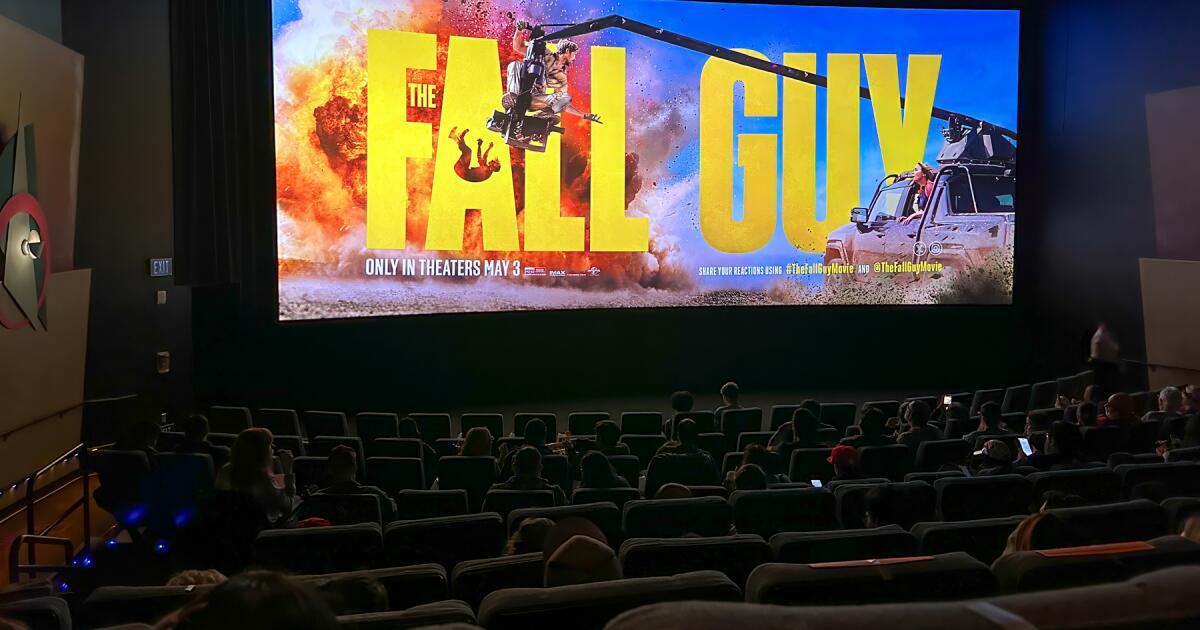
Returning to the big screen after his starring role in the Barbie movie, Ryan Gosling stars in The Fall Guy — an action-packed tribute to stunt performers in the movies.
Gosling plays the role of Colt Seavers — a stuntman who “gets blown up, shot, crashed, thrown through windows and dropped from the highest of heights, all for our entertainment. And now, fresh off an almost career-ending accident, this working-class hero has to track down a missing movie star, solve a conspiracy and try to win back the love of his life (Emily Blunt starring as Jody Moreno, director of the movie) while still doing his day job. What could possibly go right?”
Ryan Gosling and Emily Blunt
(Universal Pictures)
The Fall Guy includes the movie industry’s first-ever film credit of Stunt Designer, received by Chris O’Hara, president of Stunts Unlimited, and who is renowned as a Stunt Coordinator and second unit director. The Stunt Designer moniker goes beyond the traditional title of Stunt Coordinator (an official Screen Actors Guild credit that is also recognized by the Directors Guild of America). This credit represents a new benchmark that accurately reflects “the high-level artistic contribution of world-class Stunt Coordinators like O’Hara. These are artists who do more than coordinate the logistics of stunts; they design and create them.”
“Stunt Designers are the creative architects behind fight scenes, high falls, and more, and deserve to be recognized for the creative leadership of their contributions,” said David Leitch, director, blockbuster filmmaker and a former stunt coordinator.
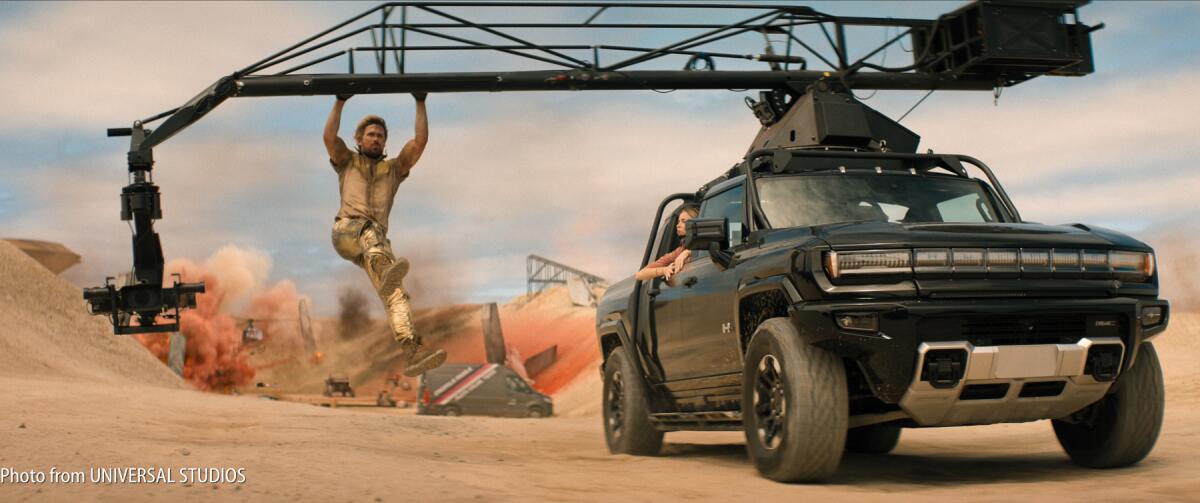
The fall guy on a vehicle-mounted arm.
(Universal Pictures)
The Fall Guy was originally a TV series from the ‘80s. It “was a reflection of that era, celebrating the cowboy spirit of stunt work,” director David Leitch says. “Back then, stunts were about sheer toughness, fearlessness, and guts. While there were tricks of the trade, these stunts still came with a lot of pain. My journey in the stunt world began during the transition from this old-school era to the modern era where stunt work began embracing new technologies and practices. As I entered the industry, visual effects and special effects were starting to revolutionize the stunt world. Wire rigs, the removal of those wires via VFX and other innovations were transforming the way stunts were performed. While shooting The Matrix, I had the opportunity to witness the cutting edge of technology and the collaborative efforts that were shaping the future of stunts. For me, it was natural to embrace both sides of stunt performing—the old-school toughness and the evolving world of visual effects. So, now, with The Fall Guy, I’m paying tribute to my early career journey as a stunt performer. While we incorporate some nods to the role of visual effects, the film maintains a raw and practical element in every stunt. With this film, we aimed to deliver action that was true to the spirit of the stunt community by incorporating techniques that have become somewhat of a lost art.”
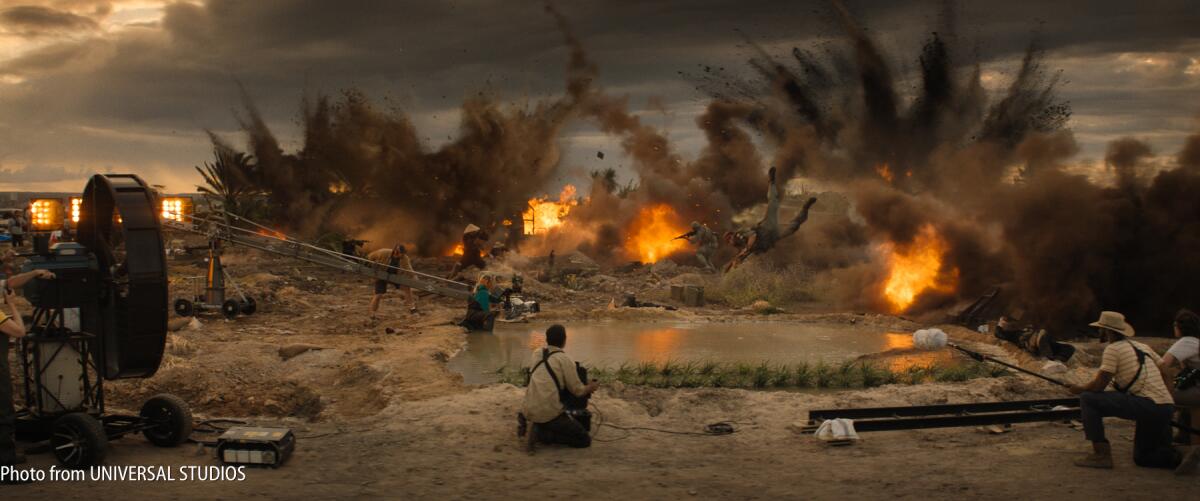
THE FALL GUY, directed by David Leitch
(Universal Pictures)
The cannon roll was a particularly spectacular stunt featured in The Fall Guy. “Stunt double Logan Holladay broke the Guinness World Record for cannon rolls in a car with eight and a half rolls.”
These days, sequences like the Alma/Colt chase sequence, in which a garbage truck dragged Ryan Gosling on a spinning bin through the streets of Sydney, Australia, included a thrilling scene on the iconic Sydney Harbour Bridge that “would normally be done with blue screen,” but “the team decided to film the scene entirely practically” — old school.
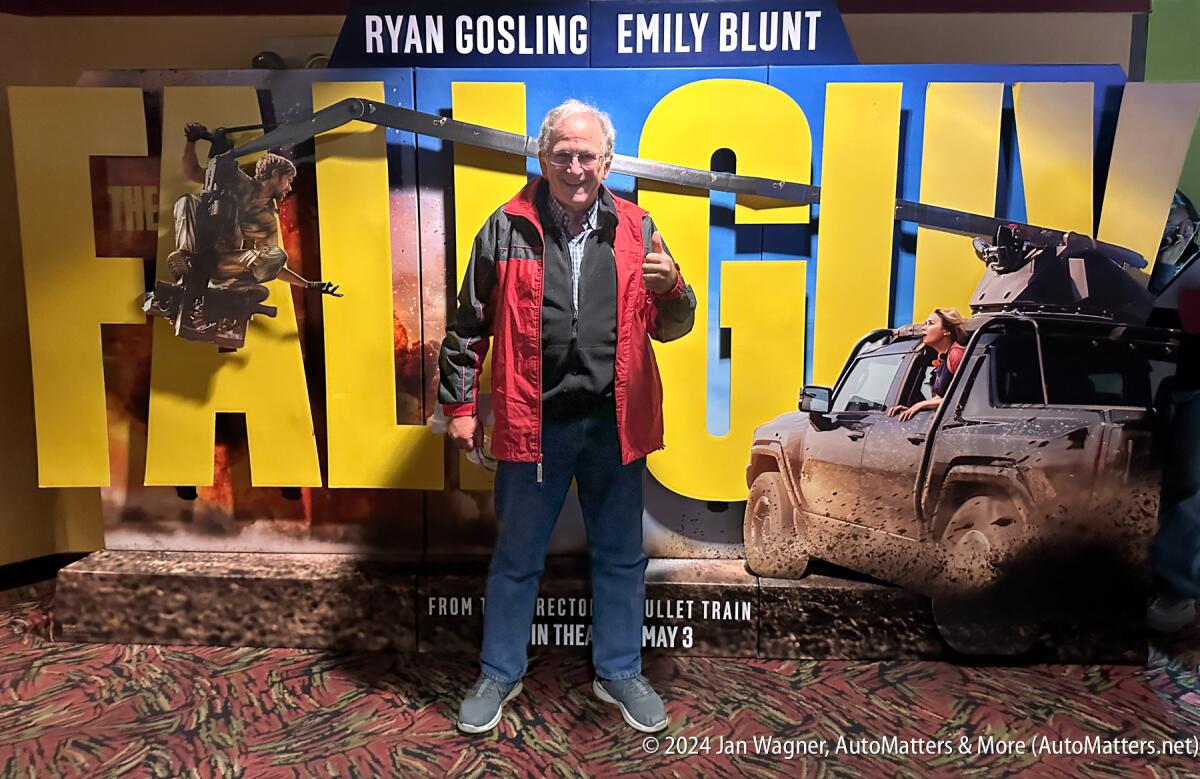
Jan Wagner in the theater lobby.
(Jan Wagner)
Another exciting stunt was a jaw-dropping 225-foot car jump, “performed by seasoned driver Logan Holladay in a specially designed vehicle, crafted for practical, in-camera authenticity that could handle such an extreme leap. At the apex of the jump, the truck was close to 80 feet in the air.
Other wild stunts included a boat jump, a high fall from a helicopter, numerous fights, fiery explosions and much, much more. Multiple costume variations were required “to address the complexity of action scenes.” Oh, and be sure to stick around for the credits to see a cameo that you will not want to miss. Thumbs up!
To see a trailer for The Fall Guy and to purchase tickets, visit the official site at: https://www.thefallguymovie.com.
To explore a wide variety of content dating back to 2002, with the most photos and the latest text, visit “AutoMatters & More” at https://automatters.net. Search by title or topic in the Search Bar in the middle of the Home Page, or click on the blue ‘years’ boxes and browse.
Copyright © 2024 by Jan Wagner – AutoMatters & More #838
-

 News1 week ago
News1 week agoPolice enter UCLA anti-war encampment; Arizona repeals Civil War-era abortion ban
-

 Politics1 week ago
Politics1 week agoThe White House has a new curator. Donna Hayashi Smith is the first Asian American to hold the post
-

 News1 week ago
News1 week agoSome Florida boaters seen on video dumping trash into ocean have been identified, officials say
-

 Education1 week ago
Education1 week agoVideo: President Biden Addresses Campus Protests
-
)
) Movie Reviews1 week ago
Movie Reviews1 week agoThe Idea of You Movie Review: Anne Hathaway’s honest performance makes the film stand out in a not so formulaic rom-com
-

 World1 week ago
World1 week agoUN, EU, US urge Georgia to halt ‘foreign agents’ bill as protests grow
-

 World1 week ago
World1 week agoIn the upcoming European elections, peace and security matter the most
-

 World1 week ago
World1 week agoArizona Senate repeals near-total 1864 abortion ban in divisive vote





